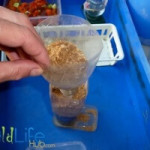The number one reason crickets eat each other is an unreliable food and water supply
 The number one reason crickets eat each other is lack of food and water. Crickets are omnivorous and eat both animal and plant material, and will readily eat each other if their basic needs are not met.
The number one reason crickets eat each other is lack of food and water. Crickets are omnivorous and eat both animal and plant material, and will readily eat each other if their basic needs are not met.
Crickets that have just molted are prime targets as they have difficulty moving and have a soft new skin. Once a cricket has finished molting it will have a big appetite, as its new white skin loses water easily and it needs lots of fluid to pump up and fill its larger Skin. So no matter what life stage your cricket, they are either prone to being eaten or will want to eat their neighbor. In short, always have plenty of water and food available.
Below are some tips to maintain sufficient food and water and reduce cannibalism:
- You may be surprised how much water crickets consume in warm weather. For instance a standard cricket breeding container of 18.5 gallons (70l) which houses around 700 or more crickets will consume 17 Oz (500ml) or more per week. Water consumption is highest when your crickets reach medium to large size and in hot weather. This amount of water can be difficult to maintain with water bowls unless you regularly fill them up.
- Automated food and water dispensers are ideal for this as they will dispense just the right amount of food to your crickets at all times. After a lot of experimentation we have worked out how to make them so they are easy and cheap to build, robust, and designed not to fall over. Click her for more details on our automated food and cleaning systems.
- If you have just bought crickets from the pet store, be sure to replace old food with fresh food such as carrot and gut load mixture. Gut load mixture often comes with bought crickets. After this is finished provide a good quality food mix which you can get from here.
- If you use water bowls in your cricket container, be sure to place pebbles or washing gauze in the tray to prevent crickets from drowning. Sponges are commonly used, however they can be difficult to clean and often need to be replaced. Washing gauze is easily cleaned and reused.
- Some people prefer to provide fresh fruit and vegetables instead of using bowls or dispensers. If this is the case, be sure to; add fresh wet food; and top up dry food reserves every day without exception. If you use food and water dispensers then you can feed your crickets wet food every second day or longer.
- If there are low humidity conditions (common in winter), then increase humidity by placing a container of water with pebbles in it so they don’t drown and can crawl out.

 The number one reason crickets eat each other is lack of food and water. Crickets are omnivorous and eat both animal and plant material, and will readily eat each other if their basic needs are not met.
The number one reason crickets eat each other is lack of food and water. Crickets are omnivorous and eat both animal and plant material, and will readily eat each other if their basic needs are not met.